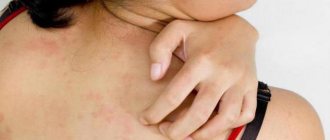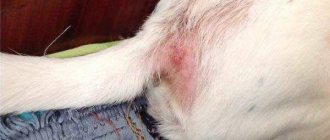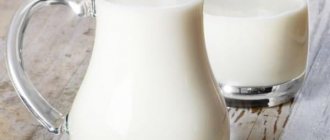Inappropriate reactions of the immune system to various substances are called allergies. A harmless substance, entering the body, and often simply coming into contact with the skin, leads to the production of histamine and manifests itself in skin, respiratory, gastroenterological and other manifestations.
Allergies often cause cheilitis – inflammation of the mucous membranes and the outside of the lips. The red border of the lips, which should decorate the face, turns out to be inflamed, the lips crack, not only causing pain, but also disfiguring the appearance.
Types of cheilitis
Cheilitis, often called cheilitis, is often recurrent in nature - once cured inflammation easily returns again. It has a different nature.
Allergic contact
Allergic cheilitis appears as a result of sensitization of the body by substances perceived by the immune system as an enemy. It is of a contact nature and most often affects women aged 20-40 years.
Usually has a delayed effect. The development of a pathological reaction requires a different period of time - from a week to several months. The speed of manifestation is largely determined by the characteristics of the endocrine and immune systems, as well as the frequency of contact with the allergen. The development of allergic cheilitis is provoked by contact with local irritants, mainly cosmetics.
Atopic
Atopic dermatitis and neurodermatitis often affect the mucous membranes and outer part of the mouth. The nature of the disease is also allergic; medications, microorganisms, and toxic damage from various substances, including foods, can irritate the immune system.
Actinic
This type of cheilitis is allergic in nature and is provoked by ultraviolet radiation. Therefore, periods of exacerbation are observed with increased sun activity - from spring to autumn. When the amount of sunlight decreases, the disease goes away on its own.
Other types of damage to the lips are of two types - primary diseases localized on the red part of the lips, and the result of other pathologies, skin pathologies and diseases of the nervous system.
Macrocheilitis
Lip disease is part of Melkersson-Rosenthal syndrome (MRS). This is a rare chronic disease in which, in addition to severe swelling of the lips, often asymmetrical, the facial nerve is also affected, and folding of the tongue is observed. One of the reasons is considered to be an allergic component.
Exfoliative
The disease does not affect the mucous membranes; the lesion affects only the outer part of the lips. The main causes are disorders of the nervous system, as well as increased anxiety and endocrine pathologies, mainly excessive secretion of the thyroid gland.
Glandular
The cause of lip inflammation is infection of the salivary glands, as well as the resulting general intoxication. Most often observed after 30 years in patients of both sexes.
Meteorological
The condition of the surface of the lips depends on weather conditions - humidity, wind, frost. Mostly men suffer, who are not inclined to take care of their skin and protection from external influences.
Hypovitaminosis
Dryness and skin pathologies are caused by poor nutrition with a lack of vitamins, mainly group B, as well as E, A. Damage covers the mucous membranes, tongue, hyperemia, swelling, and severe pain are observed.
Causes of development of cheilitis caused by allergies
Most cheilitis is of an allergic nature. Various substances enter the body and provoke reactions. This influence is not only of a contact nature, but is also a consequence of sensitization. Often, cheilitis is not the only sign of an allergy; respiratory symptoms and eye reactions may also develop.
The most common causes of lip inflammation in children and adults are:
- Cosmetics: lipsticks, creams, lotions. Contact cheilitis most often affects women who try to protect themselves from the negative effects of the external environment by using lipstick. Eosin, rhodamine, and other dyes and fragrances in their composition have strong allergenic properties. Despite the restrictions imposed on the amount of dyes (2%) in their production, they are the ones that most often cause the disease. Little girls often become victims of lipsticks, copying their mother’s habits and secretly using cosmetics.
- Oral hygiene products: fresheners, toothpastes, chewing gum.
- Aggressive environmental influences: sun rays, plant pollen, dust, pet hair.
- Metal and plastic often cause irritation; they are used to make piercings, dentures, mouthpieces, and pens that children love to put in their mouths. Musicians who play wind instruments often suffer from the disease.
- Dental procedures: trauma to the lips, use of metal instruments and anesthesia.
- Hot and spicy food using marinades and sauces.
- Toxic effects of infectious pathogens.
- Harmful production conditions and contact with aggressive chemicals in professional activities.
A large number of reactions are caused by products. The most dangerous for a smile include citrus fruits, red berries and fruits, pineapples, and carbonated drinks. They cause a strong local reaction due to the acids they contain, which enter the body through minor injuries to the oral cavity.
Subsequently, an immune reaction occurs, and all areas of the lips and mucous membranes are affected. Cheilitis can develop as a result of a cell-mediated immune response. And it can be caused by any product, even one that does not cause a local reaction. In this case, we can talk about food allergies.
Symptoms
According to medical terminology, the disease in question is called contact allergic cheilitis. In this case, the red border and the area of skin around the lips are affected. Sometimes the mucous membrane of the oral cavity is also involved in the process. First, an allergy on the lips manifests itself as redness at the site of contact with the causative factor.
Soon, bubbles with transparent contents appear on the affected areas, which quickly burst. Erosion, crusting, and cracks form. Patients experience itching, burning and swelling. But there are also less pronounced symptoms, when an allergy on a child’s lips manifests itself only as slight redness and peeling. A long course of cheilitis in adults leads to dryness of the red border, the formation of grooves and cracks on it.
Symptoms of lip allergies
Signs of the disease can range widely - from simple peeling to severe swelling that requires immediate response.
When a dangerous substance comes into contact, manifestations of a local reaction occur - redness of a separate area. Subsequently, the following are observed:
- Signs of a reaction
burning, swelling, itching;
- unnaturally red lips;
- peeling;
- cracks, sometimes deep;
- the formation of small bubbles, after their rupture, areas with ulcers and erosions appear;
- formation of crusts and removal of entire layers of skin;
- swelling and hyperemia of the mucous membranes, which become painful when pressed.
Allergic reactions can develop rapidly. The gradual accumulation of a dangerous substance in the body can be resolved by the development of edema - swelling of the lips caused by the accumulation of fluid in the tissues. Dangerous symptoms of edema are:
- change in color of the red border of the lips and nails to bluish, purple, whitish;
- transformation of the shape and size of the lips;
- swelling of the mucous membranes;
- swelling of the tonsils, throat, tongue;
- appearance of a rash:
- breathing problems: shortness of breath, lack of air, wheezing;
- febrile state with rising temperature.
These signs may also be symptoms of anaphylactic shock or angioedema.
Rapidly developing difficulty breathing requires immediate medical attention and calling an ambulance.
Quincke's edema
Swelling of the lips is the first symptom of Quincke's edema. It is also called giant urticaria and is an acute allergic reaction.
The peculiarity of this phenomenon is the rapid increase in symptoms. If your lips are sharply swollen, have doubled in size or more, and there are other signs of giant urticaria, you should call an ambulance.
Signs of this disorder include:
- swelling of the lips, tongue, larynx;
- skin hyperemia;
- small rash around the swollen area;
- headache;
- nausea and vomiting;
- dyspnea;
- tachycardia;
- general malaise.
Any allergen can cause giant urticaria. The most common causes are pollen, animal dander, chemicals, and medications. Giant urticaria occurs from insect bites. According to statistics, children encounter this immunopathological process more often than adults (8% of cases versus 2%).
There are also hereditary forms of angioedema associated with congenital pathologies of the thyroid gland, liver or immune system.
First aid
If a person’s eyes and lips are suddenly swollen, he should:
- Apply a cold compress to the affected area.
- Take a tablet of any antihistamine.
- Drink plenty of fluids.
- Call an ambulance.
Before the medical team arrives, you are allowed to drink a soda solution (1 g of soda per 1 liter of water). This reduces the rate of spread of the pathological process to the respiratory system.
Drug treatment includes the administration of corticosteroids, diuretics, and immunomodulatory therapy. The treatment regimen is determined by the doctor. In some cases, emergency hospitalization is necessary.
Diagnostics
If symptoms of cheilitis appear, you should contact your physician/pediatrician. They may be prescribed consultation and treatment with an allergist-immunologist or dentist.
Allergy must be differentiated from actinic, atopic and exfoliative types of cheilitis. Specialists can do this by looking at the lichenification of the labial border, hyperemia and the characteristics of the skin scales. Herpes often develops on the lips and mucous membranes - blisters filled with liquid, which are the result of a viral infection. They are determined by appearance and examination of blood or a smear from the rash.
Laboratory tests include:
- blood tests: general for immunoglobulins E and G (they increase with the production of specific antibodies);
- skin tests: patch, intradermal, drip, scarification and prick tests;
- tests to determine the allergen using blood serum.
It is also possible to use the elimination method, in which possible allergens are sequentially excluded and the reaction is monitored.
In most cases, patients have a polyvalent nature of the disease, that is, reactions are caused not by one substance, but by a group.
Blood tests
Serum tests avoid skin reactions and are therefore safer. They can be carried out from a very early age. Usually, studies are carried out on a large group of substances at once - a line of allergens. In this case, it is possible to estimate quantitative parameters - the degree of sensitivity to each reagent.
The presence of immunoglobulin E in the blood indicates the allergic nature of the disease. Immunoglobulin G is a marker of food intolerance.
Skin tests
This research method is considered one of the most reliable. It is recommended from the age of 6 years, sometimes performed earlier. They come in several types depending on the method of implementation: drops of allergens or applications with them can be applied to the skin, injections can be made, or additional scratches with a scarifier. The allergen is identified by redness and swelling in a certain area.
Performing application tests on the mucous membrane is difficult, since you need to keep the product for a certain time. Usually a tampon or denture is used to fix the reagent.
Treatment
Treatment of allergic diseases requires a whole range of measures. The main one is removing the allergen, which is often very difficult. You can use another type of lipstick, but it is often not possible to avoid contact with dust, pollen or sunlight.
For first aid if dangerous symptoms appear:
- Thoroughly wash off all cosmetics from your face, using only plain water without soap or hygiene products.
- Provide cool drink - clean water.
- In case of severe swelling, take a sorbent and an antihistamine.
- Call a doctor.
If there is difficulty breathing, call an ambulance, since severe forms of allergies are treated in a hospital with intravenous and hourly drip administration of drugs.
Symptomatic pharmacotherapy and physical procedures
Treatment with medications helps relieve swelling, itching and alleviate the condition:
- sorbents are used for desensitization: white and activated carbon, multisorb, atoxyl;
- antihistamines: loratadine, suprastin, chloropyramine, zodak;
- means for local treatment - ointment, aerosol: corticosteroids hydrocortisone, dexocort, soderm;
- antibiotics for infected wounds;
- angioprotectors to improve blood supply: troxevasin;
- sedatives: Persen, Novo-Passit;
- vitamins and immunostimulants.
Complex therapy helps to quickly cope with inflammation by eliminating the allergen. Sometimes physiotherapy is prescribed - magnetic therapy, Bucca rays. The treatment prognosis is favorable.
Folk remedies
Traditional medicine suggests using herbal infusions to strengthen the immune system and topically to relieve inflammation:
- recipe 1: mix hawthorn and rose hips in equal parts, pour 3 tbsp into a thermos. spoons, pour 0.5 liters of boiling water, leave for 2 hours, drink half a glass three times a day.
- recipe 2: apply a fresh aloe leaf to the affected areas, hold for 15 minutes, let the juice dry.
It is useful to lubricate your lips with sea buckthorn oil for cracked skin and open wounds.
Allergic reaction to lipstick: causes, symptoms and what to do
All girls and women dream of being bright and emphasize their individuality in every possible way, but often experiments do not end as well as we would like.
Negative skin reactions to cosmetic products are becoming an increasingly common concept. Therefore, it is advisable to warn yourself and study all the nuances of this issue. The range of cosmetics is very wide and lipstick occupies a special place in it.
Treatment
Of course, further use of lipstick should be completely excluded, so it is appropriate to get rid of it immediately.
Choosing medications on your own is often useless and can make the situation worse.
It is best to visit a dermatologist if you have skin irritation. Only he will be able to prescribe the correct treatment after performing preliminary tests. Most likely, you are recommended to adhere to a certain diet, use ointments or creams with a hormonal basis ( Advantan , Elokom ).
Drug treatment also involves taking antihistamines ( Cetrin , Zodak , Suprasti ). Consult your doctor before use! It is best to carry the medicine with you at all times, since an allergy attack can happen at any time.
In order to avoid further problems, the name of the identified allergen must be remembered.
ethnoscience
The most accessible and simple treatment option is still the advice of our grandmothers. In this situation, it is recommended to make a tincture of peppermint and use it 3 times a day, 2 teaspoons. Fish oil, which is best applied at night, will also not be amiss. It will help speed up the regeneration process and moisturize the skin of the lips.
Complications
Under no circumstances should you treat this type of irritation leniently and neglect treatment. Such composure can cause a chronic form of the disease, anaphylactic shock and swelling of the respiratory tract.
Prevention
First of all, girls with a predisposition and increased sensitivity of the mucous membrane are susceptible to allergies to lipstick. In order to avoid this kind of trouble, you need to take the most responsible approach to choosing a product. Well-known brands and companies do not guarantee good quality.
Everyone needs to study the composition of lipstick, as it may contain harmful and dangerous components.
The most common substances that contribute to the development of allergies:
- For a longer shelf life, the manufacturer adds preservatives , which can have a negative effect on the skin.
- Fragrances are used to neutralize unpleasant odors . Cosmetics, of course, acquire a pleasant aroma, but they do not always interact well with the mucous membrane.
- For bright and rich color, dyes . The most dangerous of them is aniline, but this does not prevent some companies from actively using it.
When going to the store, you need to remember that every manufacturer tries to work not at a loss, which is why many often use low-quality materials and dangerous components. Do not believe advertisements and advice from others.
Each person is unique and what works for one may be disastrous for another. Carefully study the composition of cosmetics and check them for possible allergens.
Source: //allergiyas.ru/allergicheskaya-reakciya-na-pomadu-prichiny-simptomy-i-chto-delat/
Prevention
The aggressive effects of the external environment and allergens can be minimized if you follow the rules of hygiene and give up bad habits. The following measures will help you avoid cheilitis:
- Complete removal of the allergen from life.
- Use of safe, hypoallergenic cosmetics (cosmetics that have expired should also not be used).
- Monitor oral hygiene, promptly treat teeth and throat.
- Do not take medications uncontrollably.
- Do not stay in the cold or open sun for a long time, use protective equipment.
- Give up the habit of putting pens, pencils and other objects into your mouth, and biting your lips.
- Strengthen your immune system and eat vegetables and fruits, whole grain cereals.
If signs of irritation and cracking of the skin appear, immediately begin treatment. This will help prevent the disease from starting and help you achieve recovery faster. Cheilitis can have a chronic course and should not be neglected.









